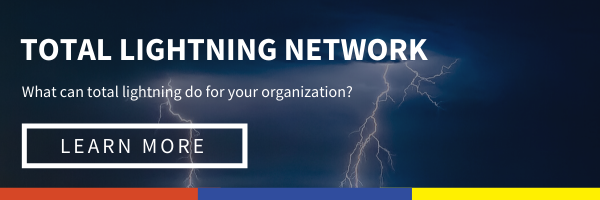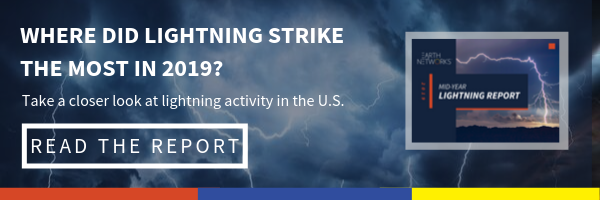What Is Lightning?
We’re sure you’ve seen lightning before, but can you really answer the question: “What is lightning?”
Welcome to lightning 101! How many lightning facts do you know? Add some more in a flash with the following lightning facts from our lightning scientists and meteorologists.
Don’t Have Time to Read the Entire Guide Now?
Download a PDF version of the guide you can reference later.
👇 Keep Scrolling to Start Reading!👇
What IS Lightning?

Lightning is the occurrence of a natural electrical discharge of very short duration and high voltage between a cloud and the ground or within a cloud. This violent and sudden electrostatic discharge generates a bright flash and thunder.
Thunder is the noise that lightning makes when it flashes and heats up the air. This quick video from the Met Office below easily explains what thunder is.
We call storms that have lightning thunderstorms.
Lightning Development
While scientists aren’t exactly sure why lightning happens, they do know how it happens.
It starts when an electric current forms in a cloud. When the ground is hot, it heats up the air directly above it. As warm air rises, the cloud expands, getting bigger and bigger. However, the whole cloud isn’t warm. In the tops of clouds, temperatures are actually below freezing. It’s so cold that the water vapor turns into ice!
When this hot air and cold air meet, a thunderstorm forms. A lot of tiny pieces of ice bump into each other as they frantically move around within the cloud. This is the beginning of a lightning bolt. These particles slamming into each other create an electrical charge.

As the cloud fills up with electrical charges, lighter positively-charged particles form at the top of the cloud. The heavier negatively-charged particles sink to the bottom. When both charges grow large enough, lightning occurs between them.
Lightning heads from the cloud towards the ground and becomes a danger to those outdoors when a buildup of positive charge forms on the ground beneath the cloud. This is attracted to the negative charge at the bottom of the cloud, so it concentrates around anything that sticks up into the air. That’s why trees, air-traffic control towers, and even people make great lightning conductors! The positive charge from the ground connects with the negative charge from the cloud, creating cloud-to-ground lightning.
Despite the appearance of the lightning strike coming down from the cloud, the positive charge reaching up from the ground causes a white hot bolt of lightning to fracture the skyline.
You can do more reading on lightning basics with our friends at the National Oceanic and Atmospheric Administration.
What About Thunder?
We can’t forget about thunder! A lot of people wonder what causes thunder or why it happens in the first place. The answer is: Lightning!
#LightningFacts A lot of people wonder what causes thunder or why it happens in the first place. The answer is: #Lightning! Share on XBut how? As we mentioned before, lightning can get pretty hot. But it also heats the air channel near it to around 18,000 degrees Fahrenheit. This causes the air to rapidly expand. It’s this air expansion that creates the loud boom of thunder.
While thunder can be heard from 25 miles away, that doesn’t mean the storm is a safe distance away. Especially since lightning strikes can extend over 10 miles away from a storm cloud. This makes thunder a poor indicator of when to go indoors to safety but if you have no other alerting system, remember: When thunder roars, go indoors!
Types of Lightning
How Many Types of Lightning Are There?
Close your eyes and picture a lightning strike.
We bet you’re picturing a bolt that seems to extend from the clouds down to the ground, tree, or building.
These types of lightning strikes, called cloud-to-ground lightning strikes, only make up approximately 20% of all lightning strikes. What type of lightning makes up the other 80%?
It’s the type of lightning you don’t always see: in-cloud lightning. In-cloud lightning strikes jump from cloud-to-cloud up in the sky.
Total Lightning Definition
During a thunderstorm, there are both in-cloud and cloud-to-ground lightning strikes. When you count both of these lightning strike types together, you call it “total lightning.”
Total Lightning: The combination of in-cloud lightning and cloud-to-ground lightning
#LightningFacts The combination of in-cloud #lightning and cloud-to-ground lightning is called total lightning ⚡️ Share on XLightning alerts that go off just cloud-to-ground lightning strikes aren’t very good, since they only alert on 20% of all strikes. To alert on cloud-to-ground and in-cloud lightning, you need tools that rely on a total lightning detection network.
“Bolts from the Blue”
While “a bolt from the blue” refers to something totally unexpected, it’s also a real term we use to describe lightning strikes.
Bolt From The Blue: This dangerous occurrence is a flash of lightning that extends outward from a storm cell. It can extend so far away from the storm cell that it shows up in an area that isn’t experiencing any other storm conditions. Therefore, it can strike unexpectedly somewhere away from the storm where skies are blue and total lightning alerts aren’t implemented.
Side Flashes
When lightning is nearby, you could also become a victim of side flashes.
Also known as a side splash, a side flash is a type of indirect lightning strike that occurs when lightning strikes a taller object near the victim and a portion of the current jumps from the taller object to the victim.
The National Weather Service describes this phenomenon by likening the victim to a “short circuit” for some of the energy in the lightning discharge.
You can learn more about other types of dangerous lightning strikes on our Struck By Lightning Page.
Heat Lightning
What some people call “heat lightning” is just a thunderstorm that’s too far away to hear the thunder. Some nights in the summer, you can see distant lightning from a storm over the horizon, maybe 200 miles away. This is lightning flashes off of clouds high up in the sky.
This is a pretty common misconception so, to reiterate, there is no such thing as heat lightning! What you are seeing is a distant thunderstorm too far away to hear the thunder. But that storm could be heading your way, so you should always take precautions when you see lightning.
Lightning as an Indicator of Severe Weather

When you break it down, lightning is the most reliable indicator of storms. In fact, we detect lightning in an overwhelming majority of storm reports within a 30 km radius and 45 minutes before and after a severe weather event.
Here are some lightning stats for different types of severe weather:
![]() 90% of high wind reports include lightning
90% of high wind reports include lightning
![]() 94% of tornado reports include lightning
94% of tornado reports include lightning
![]() 99.6% of hail reports include lightning
99.6% of hail reports include lightning
Lightning is a part of most dangerous and destructive weather events. The image below shows all the tornado and high wind reports from 2013 in the United States with lightning.

This next one shows the reports without lightning.

As you can see, lightning is present in a vast majority of severe weather reports.
You can read an example of lightning generating reports for tornadoes in Lee County, Alabama, on our blog.
Lightning Safety Tips
Now that you understand what lightning is and have some basic lightning facts under your belt from the previous section, let’s move onto lightning safety. In this section, we’ll cover:
![]() When you’re most vulnerable to lightning strikes
When you’re most vulnerable to lightning strikes
![]() Common side effects of lightning strikes
Common side effects of lightning strikes
![]() Basic lightning safety tips
Basic lightning safety tips
When Lightning is Most Dangerous
Most people would think that they’re most at risk during a thunderstorm when it’s directly overhead; However, that’s untrue. By the time a thunderstorm is overhead, most people have already sought shelter.
Believe it or not, there is a “sweet spot” of sorts when it comes to lightning incidents.
The greatest number of lightning casualties happen right before a thunderstorm arrives and right after it begins to depart.

Oftentimes, people do not seek shelter or stop outdoor activities quickly enough to protect themselves from the lightning strikes that occur before the storm arrives.
On the other hand, the appearance of the sun after a storm may lure people out of shelter to resume outdoor activities when lightning is still within striking distance.
That’s why you’re most vulnerable to lightning strikes directly before and after a storm passes overhead.
Common Side Effects of Lightning Strikes
Lightning is one of the leading causes of injury and death from severe weather. It only takes 3 milliseconds for lightning to travel through your body and while most lightning victims survive, the effects of being struck by lightning can be lifelong.
So what happens when you’re struck by lightning? Victims often report a variety of long-term and debilitating symptoms, such as:
![]() Vision loss
Vision loss
![]() Personality changes
Personality changes
![]() Slower reaction times
Slower reaction times
![]() Chronic pain
Chronic pain
![]() Ringing in ears
Ringing in ears
![]() Depression
Depression
In the short term, a person struck by lightning may experience:
![]() Third-degree burns
Third-degree burns
![]() Lichtenberg figures (scarring from burst blood vessels)
Lichtenberg figures (scarring from burst blood vessels)
![]() Cardiac arrest
Cardiac arrest
![]() Ruptured eardrums / hearing loss
Ruptured eardrums / hearing loss
These are some pretty serious side effects! It’s best to avoid lightning altogether and seek shelter when severe weather comes to town.
Basic Lightning Safety Tips
Safety tips are some of the best lightning facts we can share with you, so let’s get review the basics.

When thunder roars, go indoors.
The only way to 100% protect yourself from lightning is to enter a lightning-safe shelter before it becomes a threat. No place outside is safe during a thunderstorm.
Stay safe indoors.
Once indoors, you must still be vigilant because there are still ways thunderstorms can harm you. Stay away from water and electric equipment until the storm passes.
Stay away from trees and other places where lightning is likely to strike. Never seek shelter under trees, tents, or other places that are not lightning safe. If you are out in the open, crouch down away from trees and poles.
Help right away if someone is struck.
Contrary to common belief, a victim of a lightning strike does not carry an electric charge and it is safe to touch them, move them, and perform CPR. This is because the lightning travels from one point to another and passed directly through person.
5 Lightning Facts

The following lightning facts will help you stump your friends and maybe even win a trivia question or two. Here are some fun lightning facts that might shock you.
![]() Lightning is the most misspelled word in weather. The correct spelling is “lightning” not “lightening”
Lightning is the most misspelled word in weather. The correct spelling is “lightning” not “lightening”
![]() At 54,000 degrees Fahrenheit, a lightning bolt is roughly five times hotter than the surface of the sun
At 54,000 degrees Fahrenheit, a lightning bolt is roughly five times hotter than the surface of the sun
![]() Lightning kills more than 2,000 people per year worldwide. Most of these deaths occur in places without sufficient severe weather alert systems
Lightning kills more than 2,000 people per year worldwide. Most of these deaths occur in places without sufficient severe weather alert systems
![]() Globally, there are about 40 lightning strikes per second – That’s more than 3 million lightning strikes per year!
Globally, there are about 40 lightning strikes per second – That’s more than 3 million lightning strikes per year!
![]() Lightning can – and often does – strike the same place more than once
Lightning can – and often does – strike the same place more than once
Tweet your favorite #lightningfacts
#LightningFacts Lightning is the most misspelled word in weather. It's #lightning not lightening ⚡️ Share on X #LightningFacts At 54,000 degrees Fahrenheit, a lightning bolt is roughly five times hotter than the surface of the sun ⚡️ Share on X #LightningFacts Lightning kills more than 2,000 people per year worldwide. Most of these deaths occur in places without sufficient #severeweather alert systems ⚡️ Share on X #LightningFacts Globally, there are about 40 #lightning strikes per second - That's more than 3 million lightning strikes per year! ⚡️ Share on X #LightningFacts #Lightning can - and often does - strike the same place more than once ⚡️ Share on XInterested in learning more about lightning? You can learn about how many lightning strikes hit the U.S. on our 2019 Mid-Year Lightning Report.
Lightning In The News
Let’s explore the impact of lightning in the real world with some stories in the news. You can use your newly-learned lightning facts to understand these events better.
The Lightning Capital of the World
 Did you know there’s a place where lightning strikes over 300 days per year? An area of Venezuela known as “Maracaibo’s Lighthouse” is the lightning capital of the world according to NASA. This area sits on Catatumbo Lake and sees so much lightning thanks to its geography near the Equator. When the warm Caribbean Sea and winds from the north collide with the cool Andres Mountain breezes from the south, the area sees optimal conditions for thunderstorm formation.
Did you know there’s a place where lightning strikes over 300 days per year? An area of Venezuela known as “Maracaibo’s Lighthouse” is the lightning capital of the world according to NASA. This area sits on Catatumbo Lake and sees so much lightning thanks to its geography near the Equator. When the warm Caribbean Sea and winds from the north collide with the cool Andres Mountain breezes from the south, the area sees optimal conditions for thunderstorm formation.
Lightning Strikes Ground Crew Member at Southwest Florida International Airport
Lightning can be a real problem for airport operations. A 21-year-old ground crew employee was struck by lightning while backing out a Sun Country Plane at Southwest Florida International Airport in July 2017. The lightning bolt hit the plane’s tail, sending a current through the fuselage. It then knocked the employee off his feet and sent other employees scrambling to assist him. The man survived but the bolt left him with third-degree burns.
Rare California Lightning Event Generates Over 20,000 Pulses

A rare thunderstorm event in Southern California generated 20,249 total lightning pulses in a 6-hour period in March 2019. A strong atmospheric trough (low pressure) off of the eastern Pacific Ocean helped push a potent cold air front toward Southern California to cause this lightning event.
Teenagers Struck By Lightning Survive
Lightning can also be a real problem for parks and recreation facilities. Two teenagers were struck by lightning in an Arizona park in August 2018 when they started going home after noticing rain. One teenager was in a medically induced coma for three days before waking, fortunately without any burns on his body. He describes being struck as “a burst of heat and then darkness.”
Volcanic Thunder Sound Captured for First Time by Scientists
Scientists have for the first time captured the cracking sound of volcanic thunder. Sometimes ash clouds rising from volcanoes contain lightning, which observers previously said produced an eerie popping sound. But in 2018 scientists managed to record the thunder produced by the Bogoslof volcano in Alaska for the first time.
Lightning Strike Kills 1 on Siesta Key Beach, Florida
One beach-goer unfortunately lost their life on June 24, 2018 when they were struck by lightning. We sent out three Dangerous Thunderstorm Alerts prior to the deadly incident.
Lightning Injuries and Fatalities in Lake George, NY

Our very own Brian Smack, a manager on our club safety team, is a lightning strike survivor. He was camping with three others when a sudden storm approached. Lightning struck their tent platform, knocking Brian out. The bravery of two others in his group saved his life.
Our Favorite Lightning Videos
It’s harder than you might think to make a great video about lightning. Here are some of our top favorites:
How does lightning work? (Toronto Symphony Orchestra)
Watch this 2-minute animation to learn all about the electrical charges that combine to create a lightning strike. The background music from the Toronto Symphony Orchestra makes the whole lesson very exciting and intense.
What happens when a lightning strikes an airplane? (Smithsonian Channel)
On average, commercial airplanes get stuck by lightning once a year. So what happens next? This video from the Smithsonian Channel explains how planes are built to withstand lightning strikes.
The most lightning-struck place on earth (TED-Ed)
This short history lesson explains the wonders of a special place on Earth where lightning strikes 200 days out of the year.
For Kids: What causes thunder and lightning? (SciShow Kids)
Teach your kids about lightning with this short video from the SciShow Kids channel.
Earth Networks Lightning Safety Awareness Week 2018
Learn more about lightning safety and hear from a lightning strike survivor in this video series from our 2018 Lightning Safety Awareness Week program.
Learn More About Weather
Now that you’re an expert on lightning, it’s time to learn about other types of weather and safety technology! You can access all of our free Weather 101 resources on our website. Click the link below to start exploring topics like hurricanes, heat, and lightning detection!






